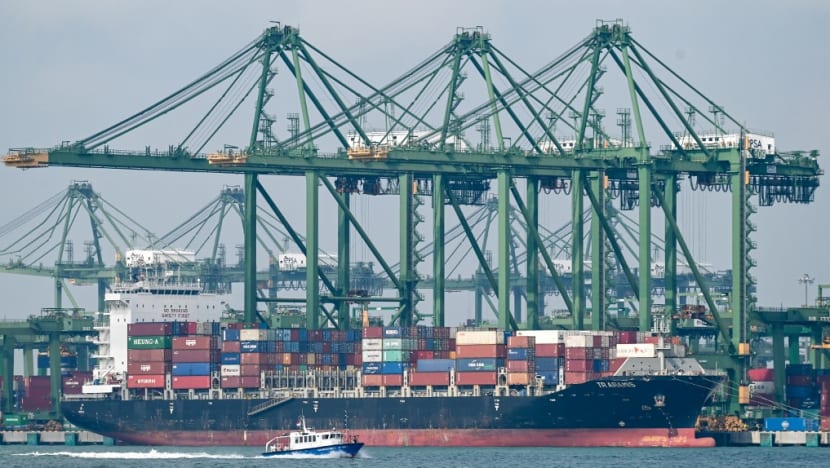CNA Explains: What's behind the 6-month slump in Singapore's key exports?
Singapore's non-oil domestic exports, a key indicator of the health of its trade-reliant economy, fell for the sixth straight month in March.

A container ship docked at Pasir Panjang Terminal in Singapore on Oct 14, 2021. (File photo: AFP/Roslan Rahman)
SINGAPORE: Singapore’s key exports have fallen for six straight months and economists are not expecting a turnaround anytime soon.
Non-oil domestic exports (NODX) – a crucial indicator of the health of Singapore's economy – shrank 8.3 per cent year-on-year last month, official data released on Monday (Apr 17) showed.
Although this was the smallest decline in recent months and when compared on a seasonally adjusted monthly basis, exports were in fact up 18.4 per cent, economists saw little optimism.
They described the jump as partly a normalisation of shipments following a weak February. Segments such as pharmaceuticals also delivered a boost in March, but these tend to be volatile from month to month.
What has remained unchanged is the challenging external environment, which will likely keep a lid on global demand.
“It is too early to call an end to the NODX soft patch,” said OCBC’s head of treasury research and strategy Selena Ling.
Q: What are these global challenges?
First, the slowdown in the global semiconductor industry.
The industry, which enjoyed a massive run-up in orders during the pandemic, has been feeling the heat of fading demand, especially in consumer electronics.
As a result, Singapore’s electronics exports, such as integrated circuits, disk media products and personal computer parts, have turned negative since August 2022.
Another double-digit plunge – at 22.3 per cent – in March meant that the global semiconductor industry downturn "remains a drag", Ms Ling said.
Second, global trade and demand for goods and services have been softening, as accelerated interest rate hikes taken on by major central banks cool economic activity.
The International Monetary Fund, for example, has issued its lowest five-year global growth projection since it started issuing such forecasts in 1990. Global growth is expected to hit 2.8 per cent this year, then hover at about 3 per cent through to 2028.
The “fog around the world economic outlook has thickened” with the recent flare-up of banking turmoil in the United States and Europe, the fund said earlier this month.
As countries push on with tight monetary policies to battle high inflation and vulnerabilities surface in the financial system, global demand will likely stay weak, economists said.
One major risk for Singapore is a sharper-than-expected global slowdown, Capital Economics’ Shivaan Tandon told CNA.
The economist expects the United States and eurozone, two of Singapore’s key demand markets, to fall into recession this year. This means a “very weak” outlook for Singapore’s exports, even with the reopening of China, he added.
So far, the reopening of the world’s second-largest economy has largely driven a rebound in domestic consumption and services.
“China’s demand for intermediate products remains weak, as implied by the worsening exports to China from South Korea, Taiwan and Vietnam,” said Maybank economists Chua Hak Bin and Lee Ju Ye.
They added that exports to China may only pick up in the second half of the year. But if demand from China still fails to pick up by then, Singapore “risks entering into a technical recession”.
Latest data showed that Singapore's non-oil exports to all but two of its top 10 markets fell. The only two markets to which exports rose in March were the US and South Korea.
As a whole, the volume of shipments to these markets fell last month, with the largest contributors to the decline being China (-14.1 per cent), Taiwan (-30.4 per cent) and Malaysia (-23.1 per cent).
UOB said the data reaffirms its belief that it is premature to call for a reverse in exports.
“We continue to expect weakness in global demand on the back of further monetary policy tightening and worries about economic slowdown in the developed markets,” said senior economist Alvin Liew.
Q: How will exports fare in 2023?
Amid the dour outlook for the global economy and trade, policymakers in Singapore have pencilled in a 2 per cent decline or zero growth for exports this year.
Private-sector economists seem even more pessimistic.
With manufacturing, especially electronics, likely to remain in the doldrums, OCBC has maintained its prediction for NODX to contract around 3 per cent in 2023.
UOB is also sticking to a full-year NODX forecast of -5.5 per cent, with Mr Liew expecting “a few more months of year-on-year declines” before some improvements in the second half of the year.
Likewise maintaining its forecast, Maybank expects NODX to contract between 4 and 7 per cent in 2023.
Q: What does this mean for Singapore’s growth?
Singapore's exports reached S$710 billion (US$532 billion) last year, with non-oil domestic exports at S$199.2 billion.
Given how export-driven the country's economy is, it is unsurprising that growth has started to hit the brakes.
Advance estimates showed the economy grew just 0.1 per cent year-on-year in the first quarter, a marked slowdown from 2.1 per cent in the previous quarter.
The figure is also lower than the 0.6 per cent forecast by 19 economists in a Reuters poll.
The worse-than-expected first-quarter figure has prompted some economists to downgrade their 2023 forecast for Singapore’s economic growth and warn of a technical recession.
Meanwhile, the Monetary Authority of Singapore (MAS) left its monetary policy unchanged during a scheduled policy review last week.
Hitting the pause button on monetary policy tightening and a further appreciation in the Singapore dollar is aimed at giving exporters some reprieve, some economists said.
“We believe the bank would be wary of further strengthening the currency at a time when exports are in the doldrums and are the main factor weighing on (gross domestic product),” said Capital Economics’ Mr Tandon.
Several economists reckon that the central bank has reached the end of its tightening cycle and will likely maintain the current appreciation stance when it meets again in October.
Fitch Solutions said Singapore's monetary policy is expected to “still remain restrictive”, given how MAS has made five consecutive tightening moves since October 2021 to tame inflation.
It does not expect the central bank to relax its monetary policy “until 2024 at the earliest”.

















